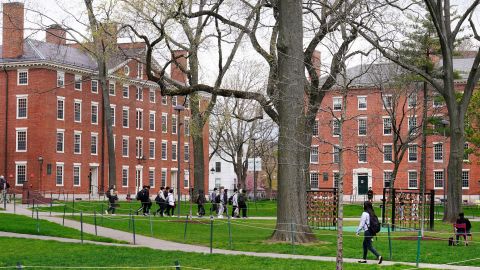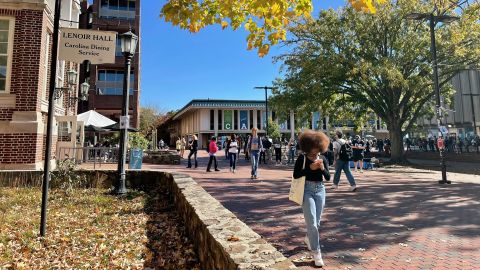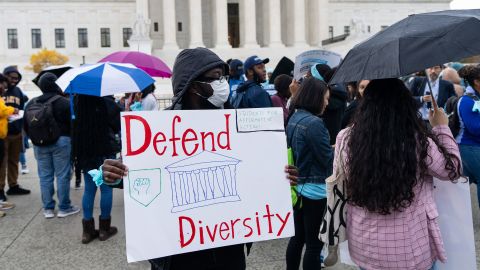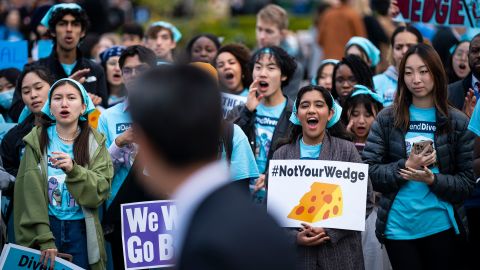CNN
—
Affirmative action is on trial again, and this time Asian Americans are at the center.
The conservative majority US Supreme Court heard oral arguments this week in two cases involving Harvard University and the University of North Carolina that challenge whether colleges and universities can continue to consider race as a factor in admissions decisions.
In the Harvard case, the conservative group Students for Fair Admissions is alleging that the university discriminates against Asian American applicants by rating them lower on traits such as leadership and likeability and holding them to a higher standard for admission than other applicants. By contrast, the plaintiff has claimed, Harvard’s admissions policies favor Black and Latino students.
There are two separate issues at play here, said Kevin Kumashiro, an educational policy expert and the former dean of the School of Education at the University of San Francisco.
“We need to address anti-Asian bias,” he said. “But we need to be careful not to say that anti-Asian bias is a sign that affirmative action is anti-Asian. That’s actually a very different question, and I think it too often gets conflated.”
The reality of where Asian Americans stand on affirmative action is complicated. A recent Washington Post-Schar School poll found that while 65% of Asians and Pacific Islanders say that colleges shouldn’t consider race in admissions, 66% also say programs designed to increase racial diversity on campus are a good thing.
Such contradictions, Kumashiro said, reflect how Asian Americans are navigating an imperfect system. CNN spoke to Kumashiro about anti-Asian bias in college admissions, why some Asian American students feel like they’re losing out and what’s next if the Supreme Court strikes down affirmative action.
The conversation has been edited for length and clarity.
What was affirmative action designed to do, and is the policy still serving its intended purpose?
In the early 1960s, the Kennedy administration put forward the idea of affirmative action in the midst of the civil rights movement. One of the arguments of the civil rights movement was that racism is baked into many institutions in society: the criminal justice system, health care, finance, housing, and of course, education.
(Affirmative action was intended as) a way to remedy historic injustices. When you compete for things like jobs and education, you’re not starting on a level playing field.
The first significant shift in how we understand affirmative action, particularly with higher education admissions, comes with the Supreme Court cases – the first of them is in 1978. The Supreme Court has actually heard affirmative action cases three times, and it’s basically the same case three times. It was people claiming that White students are discriminated against in college admissions because of the consideration of race, and that this violates the 14th Amendment and the Civil Rights Act (of 1964).
(The Supreme Court has previously ruled) that race can be considered in college admissions if two conditions apply. One is if race is one of a number of factors. The second is what’s often called the diversity rationale, which says that race can be considered if the university argues that racial diversity contributes to the educational experience for students.
It sounds as though affirmative action in higher education has evolved over time to refer to campus diversity, which is not the same as remedying systemic discrimination.
It absolutely is much more narrow to say we want more students of color on campus, rather than to say we want to change how universities have historically served to advance certain groups more than others.
Those who champion racial justice would say that affirmative action has had both pros and cons. One of the cons is that affirmative action policies aren’t being developed to remedy structural racism. They’ve been set up to increase representation. That’s not unimportant, but we need to go much farther.
One of the gains is that there’s actually a lot of evidence that affirmative action policies do increase racial diversity on campuses. When you get rid of affirmative action policies, it also decreases racial diversity.

Some Asian Americans feel that their race works against them in the admissions process, even though they encompass a diverse group and experience social disadvantages. Why do you think that is?
While many Asian American students feel that the system is working for them and they’re getting ahead, there are many who see that schools don’t work for them. The reason why is because schools don’t often work for many people. It’s not just Asian Americans.
The earliest public schools were for a very small slice of the population. You had to be male and White, and your family had to own property. It paralleled the criteria for citizenship. As schools were forced to include more and more students, they came up with more and more ways to differentiate and sort them: through segregation, tracking, labeling, discipline. We might say today that the purpose is equal educational opportunity, but historically, the function of schools was always to differentiate and sort.
Education was never built to level the playing field and in many ways, it doesn’t do so now, which is why there’s an irony around affirmative action. Simply diversifying the pot doesn’t actually change that pot. What we actually need to do is change the system, and affirmative action doesn’t go that far. Asian American students who see that the system didn’t work for them are very perceptive in recognizing that the system was never built for them.
Despite concerns that they’re being disadvantaged in college admissions, Asian Americans are demographically overrepresented at elite universities. Why is that?
Asian Americans are overrepresented in both elite universities like Harvard and also in community colleges.
With the immigration reform of 1965, there were a couple of changes to immigration patterns from Asia: More skilled labor and more international students. Both of those things actually contributed to a particular social class that becomes predominant among Asian American communities. And with a higher social class comes more access to education. With immigration reform, the pipelines into higher education did change to the benefit of Asian Americans.
Another reason is a norm among many immigrant communities, particularly middle class immigrant communities: A hyper focus on educational achievement. Asian Americans and Asian American immigrant communities often put a lot of emphasis on standard measures of educational achievement, like scoring really well on tests and doing really well in school. There’s this cultural attention paid to education that is not just a stereotype.
Once you have access to education, you see that as a path. For half a century, Asian Americans have been able to tap into that path, partly because of (the 1965 Immigration Act).
Does the holistic admissions process, as opposed to prioritizing grades and test scores, disadvantage Asian Americans?
Things like social class, income, where you went to school, zip code or geography often so strongly correlate with race that (considering these criteria) can increase representation among Black, Latinx, Pacific Islander and Native American students. We have all sorts of proxies that get used for race. It can be more difficult for Asian Americans to get in when these proxies are considered.

Sometimes people say test scores and GPA should be the primary criteria. Even those criteria are very subjective. Test scores are also highly correlated with zip code, and GPA can vary significantly, not only between schools but even within schools. Are they really objective measures of achievement or potential? No, they are a slice of who the student is. The more information we can gather to get a full picture of the students, the better able we’re going to be able to make these decisions.
Ultimately, what you want is for students to have a high quality educational experience, and I actually would agree that having a campus that looks more like society is the kind of campus we’re trying to work towards.
How should universities correct for anti-Asian bias in admissions?
One very big step that all universities should be engaging in is making sure there’s training for people involved in the admissions process. Everyone brings their biases into the room with them, and sometimes we’re aware of them, and sometimes we’re not so aware of them.
But it’s more than just diversity training. What we also need are policies that are explicitly trying to change and broaden how we think about admissions. Part of the reason biases come up and are often unrecognized is because we don’t talk about how their criteria themselves are racialized. What we think of as being well prepared or being smart or being articulate or being a leader … all of these characteristics are actually always going to be informed by culture, geography, race and social class.
So some Asian Americans feel that they face stiffer and stiffer competition for a few coveted seats at elite universities. At the same time, Asian Americans on the whole do pretty well in that system. How do you make sense of that?
The reality is that the relationship between Asian Americans and affirmative action is a very paradoxical one. On the one hand, we want what’s best for our children. Maybe for some parents that’s getting them into Harvard, and if affirmative action is preventing even more Asian Americans from getting into Harvard, (parents feel) it’s going to be even harder for their kid.
On the other hand, what’s best for our kid should be seen as what’s best for every kid. That’s the straddling that Asian Americans have to do as well. Do we advocate for ourselves or do we advocate for the just system? Why sometimes does that feel like it’s at odds?
Asian Americans are often described as a “wedge” in this fight – they’re either being used by White people or they’re standing in solidarity with Black students who are up against generations of systemic discrimination. What about their own interests here?
I think that is absolutely how a lot of Asian Americans interpret this: Am I giving up my own best interests in order for others to be able to succeed or flourish?
I’m not convinced that Asian Americans are sacrificing when we support affirmative action policies. If we agree that traditional measures of success like test scores and GPAs are accurate indicators of who is most accomplished and most promising – and therefore most eligible to get into a place like Harvard – then yes, affirmative action may actually harm you if you have those qualifications.

But those measures have long benefited certain groups, and they don’t necessarily reflect who is the most accomplished or who is the most promising. So what should be the best ways to determine whether someone is best suited for this university versus another university or whether they’re better suited than another student?
I know these are much bigger questions. If someone doesn’t want to hurt their child’s chances (of getting into an elite university) and I’m saying, “Let’s rethink the purpose of higher ed,” they’ll say that’s not what they’re talking about. But that’s the direction that we need to be moving in.
It seems that all of these students are in a zero sum game – that for Asian American students to succeed, Black, Latino and Native students have to lose out, and vice versa. Does it have to be this way?
There are so many narratives that pit groups against one another with the assumption that there’s only so much to go around. What does it mean for us to change the terms of the debate?
We as a society still seem invested in the idea that there should be certain universities that remain at the top. But if we saw higher ed as playing much more of a democratizing role, we wouldn’t want only a few small elite institutions. We’d want to really rethink what the role of institutions should be, and therefore what access should be. Too often we’re debating over access to an unjust system, rather than trying to change that system.

As Black, Latino, Native and Asian students are pitted against each other, one group that’s often ignored is what’s known at Harvard as ALDCs: recruited athletes, legacies, those on the dean’s interest list and children of faculty and staff. Those students are largely White. Should Harvard limit the numbers of those students?
I absolutely think it should, particularly legacy admissions and children of donors.
We’re already giving preferential admissions to other groups, and it happens to be groups that already have privilege in society. Why aren’t we doing the opposite? Why aren’t we trying to level the playing field using affirmative action policies to give people who have long been denied access?
Given the makeup of this Supreme Court, affirmative action seems unlikely to survive in its current form. What’s the future of higher education admissions?
One of the ways that campuses can and should continue to build a diverse pool for their student body is by looking at many aspects of the student. Some of those aspects are actually so closely correlated with race that they will help to increase racial diversity, like geography, social class, type of school, and so on.
There’s another part to this: What’s the future for higher education if it wants to address historic problems? If we think about a university serving those loftier goals, education shouldn’t be about simply preparing people to succeed in the world as it is. Education should be about making the world a better place.
Every crisis is also an opportunity. The end of affirmative action is a chance for us to hit the pause button and imagine something different.